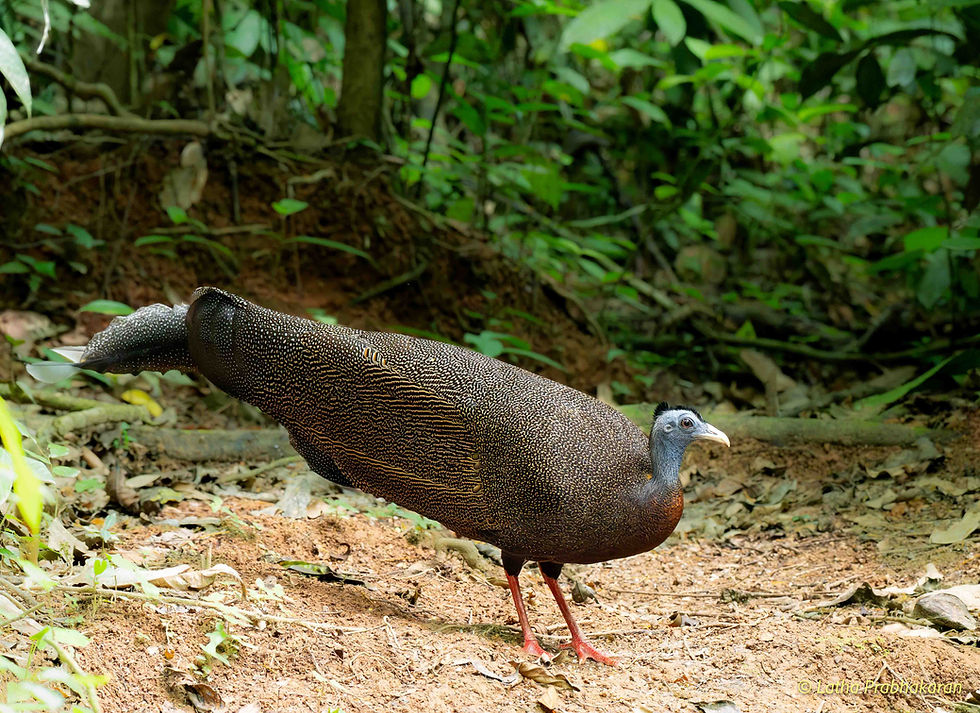An Encounter with the Great Argus in Taman Negara National Park
- devanandpaul
- 2 days ago
- 4 min read
Updated: 2 days ago
Witnessing the great argus pheasant in Malaysia’s Taman Negara National Park is a once-in-a-lifetime experience. Discover its beauty, courtship dance, and life in the rainforest.

The great argus (Argusianus argus)—one of the largest pheasants in the world—is found in the dense rainforests of Malaysia, Thailand, and Indonesia. A shy pheasant, it moves quietly through the undergrowth, its brown feathers blending perfectly with the forest floor. The male has the longest single feather, which can grow up to 2 metres (79 inches). Also, its tail feathers can extend over a metre. The female is smaller and less colourful, and has a shorter tail and fewer eyespots.
During my birding trips across Southeast Asia, I have heard the great argus’s deep, echoing kow-wow call, but the bird always stayed hidden. In this blog, I share my first encounter with this pheasant and a few interesting facts about it.

Etymology and Myth Behind the Great Argus
The great argus gets its name from Argus Panoptes, a hundred-eyed giant in Greek mythology. Hera, the goddess of marriage, women, and family, chose Argus to guard Io, her priestess. After he was slayed by Zeus, Hera transferred his many eyes to the tail of her sacred bird, the peacock.
Early naturalists exploring the rainforests of Malaysia, Sumatra, and Borneo, struck by the male pheasant’s enormous wings and tail covered with hundreds of eyelike spots resembling the eyes of the mythical Argus, gave the bird the name great argus.

The First Glimpse
After a morning birding session at Bukit Tinggi, our guide Shakti whispered, ‘If we’re lucky, we might see the great argus at Taman Negara National Park, our next destination. There’s a spot it frequents.’
By afternoon we reached the park and quietly settled into position near the ‘Argus spot’. Soon, fortune smiled on us. A male great argus emerged from the bushes like a freight train, its twin tail feathers trailing behind like ribbons.

For about 15 minutes the bird scanned the forest floor, its bluish-grey head moving slowly, then disappeared as quietly as it had appeared.
Courtship Dance
After the pheasant left, we started packing our cameras. That is when our local guide, Azmil, explained the male pheasant’s fascinating courtship ritual.
‘During breeding season, from March to July, the male chooses a spot on the forest floor and clears it completely—every leaf and twig is removed—converting it into his stage. Then he waits. Day after day, he calls—kow-wow, kow-wow—hoping a female hears him. If she comes, he begins his mating dance.
‘He steps into the courtship spot slowly, tail feathers trailing behind him. Then’—Azmil continued, gesturing with his hands—‘he spreads his wings so wide that his eyes vanish behind hundreds of eyelike spots.’

He dances step by step,’ Azmil said, ‘his tail sweeping the ground like ceremonial banners. When it’s over, he folds his wings and disappears. Sometimes the female is impressed, sometimes not. But he returns to dance again and again.’
Life of the Argus
Outside breeding season, the great argus is mostly solitary. It rummages through leaf litter for fruit, seeds, insects, and small animals. The male fiercely defends its territory and dancing ground.

Great argus pheasants lack the uropygial gland (or preen gland or oil gland) found in most birds at the base of their tails; hence, they cannot oil (or waterproof) their feathers—a surprising trait for such a large bird.
Weak fliers, they prefer walking, but if startled, they scurry into the undergrowth. Females usually lay only two eggs, carefully hidden in dense vegetation or low tree branches. Soon after hatching, the chicks leave the nest and follow their mother. Their wings grow fast, so they can fly long before they are fully grown. By their third summer, they are ready to breed.

Conservation Status
Although not yet endangered, the great argus is increasingly vulnerable, per IUCN Red List. Historically, it ranged across much of Southeast Asia—from Malaysia and Sumatra to Borneo and southern Thailand. Today, deforestation and expanding oil palm plantations are shrinking its habitat, and hunting adds further pressure—male feathers are used by Dayak people across Borneo to adorn their headdresses.

After years, my dream of sighting the great argus realized. Although I had only a few minutes with the pheasant, it was enough time for me to etch the experience on my mind forever.
‘The butterfly counts not months but moments, and has time enough.’ — Tagore

Related posts:




As usual your work is awesome